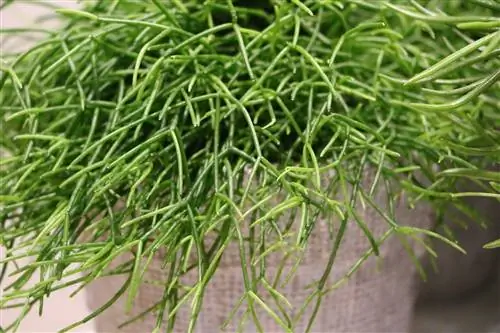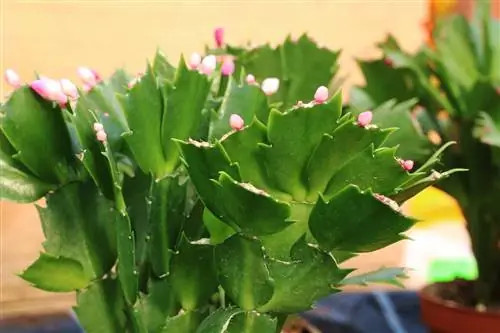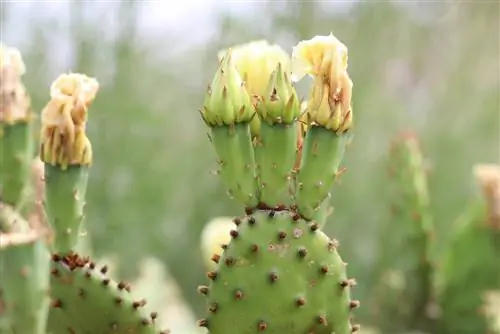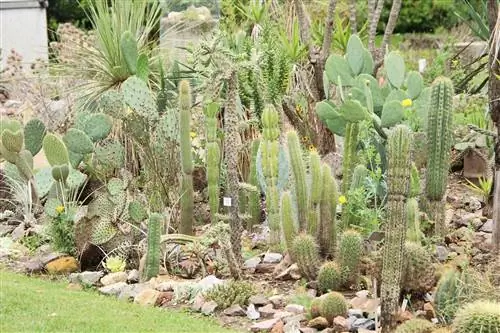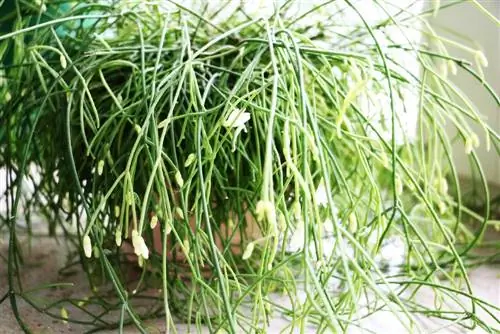- Author admin [email protected].
- Public 2023-12-17 03:39.
- Last modified 2025-01-24 12:45.
Rhipsalis baccifera also goes by the name rush cactus and has now established itself as a popular houseplant. The round cactus limbs can reach a length of several meters, which is why Rhipsalis baccifera is ideal as an ampel plant. The cactus is a succulent and sits on other plants in its native South America, which is why the plant does not form any significant root balls. The rush cactus is not frost hardy, but can spend the warm season outside, on the terrace, balcony or in the garden.
Location & plant substrate
Due to its tropical origins, Rhipsalis baccifera must be kept indoors during the cold months, but can be taken outside during the summer, either on the balcony, terrace or in the garden. Both indoors and outdoors, the plant must be protected from strong midday heat, as this leads to burns on the leaves. It is important to maintain a consistently high temperature; temperatures that are too low over time have a detrimental effect on growth and flowering. The following aspects must be taken into account when considering the location and the planting substrate:
- thrives very well in living rooms all year round
- prefers sunny to semi-shady and always warm locations
- Places with sunlight in the morning and evening are ideal
- do not expose to the blazing midday sun
- Protect from rain and wind when spending the summer outdoors
- In summer, temperatures between 20-27 °C are ideal
- lower temperatures are appropriate in winter, between 16-20 °C
- Special cactus soil is ideal as a plant substrate, available from specialist retailers
- To make it yourself, mix peat, sand and potting soil
Watering & Fertilizing
The rush cactus comes from the tropics and is therefore used to regular watering, but it should not be watered too much at once. The cooler the location of the plant, the less water it needs. Rhipsalis baccifera also prefers increased humidity; the cactus does not cope well with the often dry conditions in living spaces. Especially in winter, when the heating is running at full speed, you should pay attention to an additional increase in air humidity:
- water once a week, twice during the hot summer months, less in winter
- Allow excess water to drain off immediately to prevent rot from occurring
- Wait between watering sessions until the soil surface has dried thoroughly
- Never allow the plant substrate and root balls to dry out completely
- Be sure to avoid waterlogging, as this often leads to the death of the plant
- To increase the humidity, place water bowls on the radiators
- Spray the rush cactus periodically with water mist
- fertilize during the growing season (February to July)
- fertilize only until the buds open
- normal cactus fertilizer is sufficient, apply twice a month
- otherwise use diluted super phosphate solution
Tip:
As an alternative to conventional watering processes, the rush cactus can also be enriched with moisture using a water bath. Immerse the ball completely in water so that it can soak up, wait 10-20 minutes and then drain the excess water from the planter.
Shoots & flowers
Rhipsalis baccifera is now quite common as a houseplant in people's homes and is particularly popular because of its long and exotic-looking cactus limbs. The plant also produces flowers. If the rush cactus is given a sheltered place in the fresh air over the summer, it rewards this with a more abundant flowering phase:
- hanging growth habit, ideal as a hanging basket plant
- 2-4 mm thick and round cactus members, these are individually assembled
- can reach growth lengths of up to 4 m
- Shoots are covered with stiff bristles
- Flowering time in February
- forms small flowers in white, pink or cream color, diameter is about 1 cm
- Flowers appear on the side branches, develop only a weak scent
Repotting
The rush cactus normally only develops very few and very small roots, which is why repotting is rarely necessary. However, cacti are often offered in specialist retailers in very small planters, which often root completely over time. In this case repotting is necessary:
- best time to repot is in spring
- Carefully move the plant into a larger container
- never repot in winter, this weakens the plant
Cutting
The rush cactus does not need regular pruning for he althy growth, but pruning may prove necessary due to its long growth:
- always remove old and dead shoots
- cut off long and annoying shoots
- can be cut into the desired shape without any problems
- slightly poisonous plant sap, better wear gloves when pruning
Wintering
Rhipsalis baccifera does not observe any special winter rest and does not need a separate winter quarters. However, the plant should not be placed directly by the window so that the difference in temperatures is not too great. The following aspects should be taken into account when wintering:
- not hardy, can only go outside in summer
- likes it warm all year round
- During the winter, lower temperatures should still prevail at the location
- do not place or hang up in the immediate vicinity of the radiator
- cannot tolerate excessive heat or low humidity in heated rooms
Propagate
Rhipsalis baccifera can be propagated either by seeds from specialist retailers or by cuttings. Propagation from cuttings is usually easy to do and produces good results. As soon as new cactus members appear on the cuttings, the young plant can be accustomed to the room climate and treated like a fully grown specimen. The following criteria must be observed when propagating:
- approx. Cut 10 cm long cuttings from the mother plant
- Let the cuttings dry for about 10 days in a sunny but not too hot place
- then pot the cuttings in groups
- Planting depth should be about a third of the cuttings
- ideal plant substrate is a mixture of soil and sand, e.g. commercially available cactus soil
- Select the location of the cultivation pot in a light to partially shaded place, without direct sunlight
- optimal temperature values for cultivation are 20-23 °C
- Consistently high humidity is beneficial
- Always keep the plant substrate slightly moist, but never too wet
Tip:
In order to keep the humidity permanently high, it is recommended to put a transparent plastic bag over the cultivation pot. However, this must be ventilated daily to prevent mold from forming.
Diseases & Pests
If errors occur during care and the site conditions are not right, the rush cactus will quickly become ill or be infested with pests:
- susceptible to mites, mealybugs and mealybugs
- Check cactus regularly for infestation
- fight with neem oil-based products
- Remedies with paraffin oil also offer help
- Waterlogging caused by excessive watering leads to root rot
- Create drainage to improve soil permeability
Conclusion of the editors
The rush cactus is relatively easy to care for and thrives as long as it stands or hangs in a suitable location. Although the cactus is not winter hardy, it can spend the warm summer months outside. As a thank you for the change of location to fresh air, the gardener can expect a particularly lush bloom. Correctly dosed watering and a well-drained plant substrate are important, because constantly moist soil leads to diseases and pest infestation. Propagation can be carried out easily and quickly with cuttings, so even large spaces can be greened with these exotic cacti. Due to the hanging and long-growing shoots, Rhipsalis baccifera is suitable as an ampel plant, which also produces graceful flowers as an ornament.
What you should know about the rush cactus in brief
Profile
- Rhipsalis baccifera is quite common as a houseplant. Its limbs are approximately 2 to 4 mm thick and round.
- The cactus limbs can be up to 4 meters long and are made up of individual limbs. They hang down.
- Rhipsalis baccifera is an ideal hanging plant. The cactus is an epiphyte and originally comes from South America.
- The cacti bloom in February. The small, white or cream-colored flowers have only a very faint scent.
Location
- Rhipsalis baccifera needs a bright and warm location. The plant absolutely does not like direct sun.
- In summer the cactus likes to be outdoors, but is always protected from the strong midday sun.
- Morning and evening sun do not affect the plant. The place should also be protected from wind and rain.
- Rhipsalis baccifera can also thrive indoors all year round.
- It doesn't hibernate and likes it warm all year round. Temperatures between 20 and 27 °C are ideal.
- In winter the temperatures should be slightly lower and between 16 and 20 °C.
Planting substrate
For Rhipsalis baccifera you use special cactus soil or a mixture of peat, sand and potting soil
Pouring
- The rush cactus needs to be watered moderately but regularly.
- Between watering, wait until the plant substrate has dried.
- The plant ball should not dry out completely.
- You can dip the ball in a water bath so that it can really soak up.
- After watering or dipping, wait 10 to 20 minutes and then pour out excess water from the saucer or planter.
- Wet feet must be avoided at all costs. In hot summers, the plants need more water.
- You water less in winter. The cooler the plant is or hangs, the less water is needed.
Fertilize
Rhipsalis baccifera is fertilized between February and July, preferably with a diluted superphosphate solution or normal cactus fertilizer
Cut
The rush cactus does not need to be cut. However, long, annoying shoots can be easily removed
Propagation
- Rhipsalis baccifera is propagated by cuttings. To do this, cut cuttings about 10 cm long from the mother plant.
- These are left to dry for about 10 days in a sunny and not too warm place.
- Then you pot the cuttings, ideally in groups. The planting depth is about a third of the cutting.
- A soil-sand mixture, such as commercially available cactus soil, is suitable as a plant substrate.
- The location for the cuttings should be light to partially shaded.
- Direct sun should be avoided! Temperatures around 20 °C are beneficial, as is high humidity.
- It is therefore recommended to put a bag over the growing container.
- However, you have to ventilate daily to prevent the soil from forming mold.
- The soil must always be kept slightly moist, never wet.
- As soon as new cactus members appear, you can accustom the young plant to the room climate.
Pests and diseases
- Pests include mites, mealybugs and mealybugs. These can be combated with neem or paraffin oil products.
- Too much watering and the resulting constantly moist soil lead to the appearance of root rot, just like poorly drained soil.

